Page 48 of 368
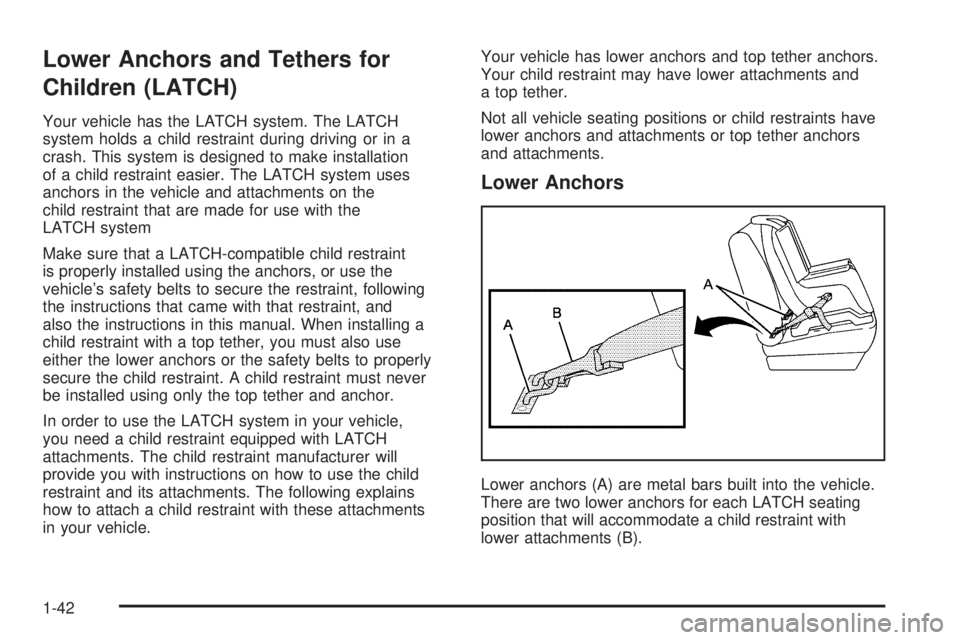
Lower Anchors and Tethers for
Children (LATCH)
Your vehicle has the LATCH system. The LATCH
system holds a child restraint during driving or in a
crash. This system is designed to make installation
of a child restraint easier. The LATCH system uses
anchors in the vehicle and attachments on the
child restraint that are made for use with the
LATCH system
Make sure that a LATCH-compatible child restraint
is properly installed using the anchors, or use the
vehicle’s safety belts to secure the restraint, following
the instructions that came with that restraint, and
also the instructions in this manual. When installing a
child restraint with a top tether, you must also use
either the lower anchors or the safety belts to properly
secure the child restraint. A child restraint must never
be installed using only the top tether and anchor.
In order to use the LATCH system in your vehicle,
you need a child restraint equipped with LATCH
attachments. The child restraint manufacturer will
provide you with instructions on how to use the child
restraint and its attachments. The following explains
how to attach a child restraint with these attachments
in your vehicle.Your vehicle has lower anchors and top tether anchors.
Your child restraint may have lower attachments and
a top tether.
Not all vehicle seating positions or child restraints have
lower anchors and attachments or top tether anchors
and attachments.
Lower Anchors
Lower anchors (A) are metal bars built into the vehicle.
There are two lower anchors for each LATCH seating
position that will accommodate a child restraint with
lower attachments (B).
1-42
Page 49 of 368
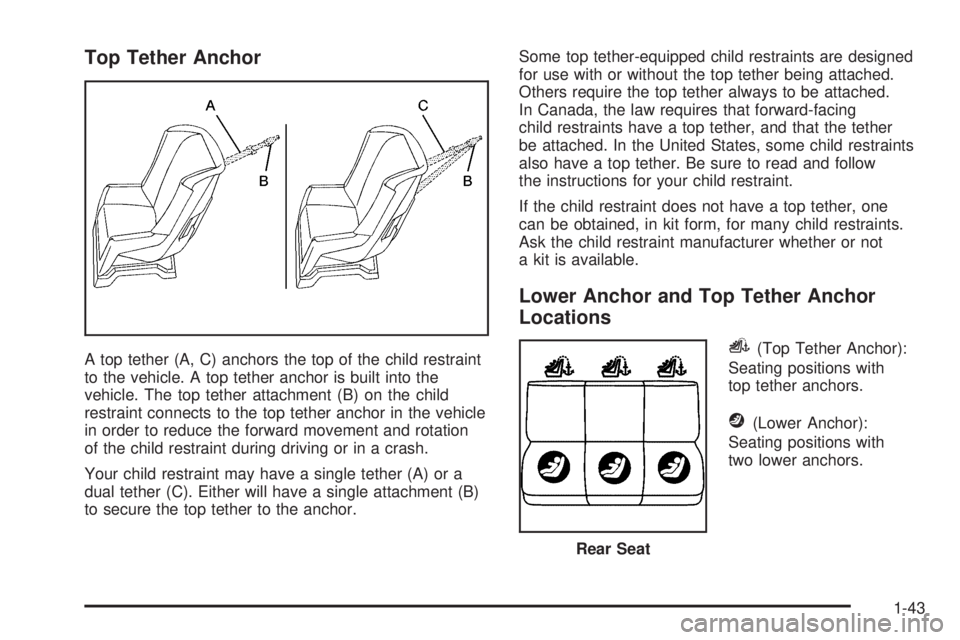
Top Tether Anchor
A top tether (A, C) anchors the top of the child restraint
to the vehicle. A top tether anchor is built into the
vehicle. The top tether attachment (B) on the child
restraint connects to the top tether anchor in the vehicle
in order to reduce the forward movement and rotation
of the child restraint during driving or in a crash.
Your child restraint may have a single tether (A) or a
dual tether (C). Either will have a single attachment (B)
to secure the top tether to the anchor.Some top tether-equipped child restraints are designed
for use with or without the top tether being attached.
Others require the top tether always to be attached.
In Canada, the law requires that forward-facing
child restraints have a top tether, and that the tether
be attached. In the United States, some child restraints
also have a top tether. Be sure to read and follow
the instructions for your child restraint.
If the child restraint does not have a top tether, one
can be obtained, in kit form, for many child restraints.
Ask the child restraint manufacturer whether or not
a kit is available.
Lower Anchor and Top Tether Anchor
Locations
i(Top Tether Anchor):
Seating positions with
top tether anchors.
j(Lower Anchor):
Seating positions with
two lower anchors.
Rear Seat
1-43
Page 50 of 368

Each rear seating position has exposed metal anchors
located in the crease between the seatback and the
seat cushion.
The top tether anchors for each rear seating position are
located on the back of the rear seatback. You may need
to adjust the rear compartment storage panel/cover in
the rear cargo area to access the anchors. Be sure to use
an anchor located on the same side of the vehicle as the
seating position where the child restraint will be placed.Do not secure a child restraint in the right front
passenger’s position if a national or local law requires
that the top tether be attached, or if the instructions
that come with the child restraint say that the top tether
must be attached. There is no place to attach the top
tether in this position.
Accident statistics show that children are safer if they
are restrained in the rear rather than the front seat.
SeeWhere to Put the Restraint on page 1-40for
additional information.
Securing a Child Restraint Designed
for the LATCH System
{CAUTION:
If a LATCH-type child restraint is not attached
to anchors, the restraint will not be able to
protect the child correctly. In a crash, the child
could be seriously injured or killed. Make sure
that a LATCH-type child restraint is properly
installed using the anchors, or use the vehicle’s
safety belts to secure the restraint, following
the instructions that came with that restraint,
and also the instructions in this manual.
1-44
Page 51 of 368
{CAUTION:
Each top tether anchor and lower anchor in
the vehicle is designed to hold only one child
restraint. Attaching more than one child
restraint to a single anchor could cause the
anchor or attachment to come loose or even
break during a crash. A child or others could
be injured if this happens. To help prevent
injury to people and damage to your vehicle,
attach only one child restraint per anchor.
A. Passenger’s Side Rear
Seat Lower Anchors
B. Center Rear Seat
Lower AnchorsC. Driver’s Side Rear
Seat Lower Anchors
Make sure to attach the child restraint at the proper
anchor location.
1-45
Page 52 of 368
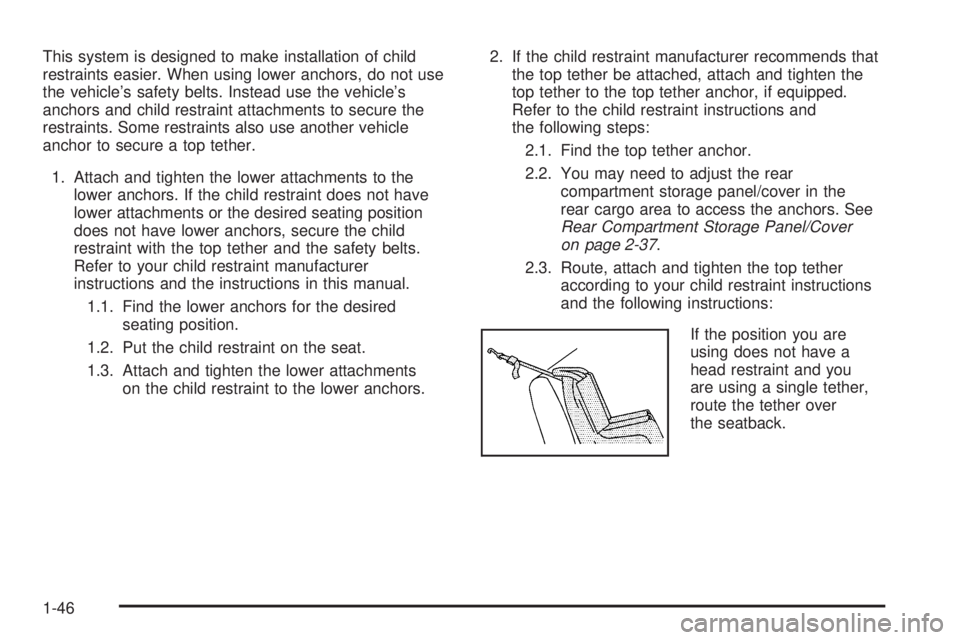
This system is designed to make installation of child
restraints easier. When using lower anchors, do not use
the vehicle’s safety belts. Instead use the vehicle’s
anchors and child restraint attachments to secure the
restraints. Some restraints also use another vehicle
anchor to secure a top tether.
1. Attach and tighten the lower attachments to the
lower anchors. If the child restraint does not have
lower attachments or the desired seating position
does not have lower anchors, secure the child
restraint with the top tether and the safety belts.
Refer to your child restraint manufacturer
instructions and the instructions in this manual.
1.1. Find the lower anchors for the desired
seating position.
1.2. Put the child restraint on the seat.
1.3. Attach and tighten the lower attachments
on the child restraint to the lower anchors.2. If the child restraint manufacturer recommends that
the top tether be attached, attach and tighten the
top tether to the top tether anchor, if equipped.
Refer to the child restraint instructions and
the following steps:
2.1. Find the top tether anchor.
2.2. You may need to adjust the rear
compartment storage panel/cover in the
rear cargo area to access the anchors. See
Rear Compartment Storage Panel/Cover
on page 2-37.
2.3. Route, attach and tighten the top tether
according to your child restraint instructions
and the following instructions:
If the position you are
using does not have a
head restraint and you
are using a single tether,
route the tether over
the seatback.
1-46
Page 53 of 368

If the position you are
using does not have a
head restraint and you
are using a dual tether,
route the tether over
the seatback.
If the position you are
using has an adjustable
head restraint and you
are using a dual tether,
route the tether around
the head restraint.
If the position you are
using has an adjustable
head restraint and you
are using a single tether,
route the tether under
the head restraint and
in between the head
restraint posts.
3. Push and pull the child restraint in different
directions to be sure it is secure.Securing a Child Restraint in a
Rear Seat Position
If your child restraint is equipped with the LATCH
system, seeLower Anchors and Tethers for Children
(LATCH) on page 1-42.
If your child restraint does not have the LATCH system,
you will be using the lap-shoulder belt to secure the
child restraint in this position. Be sure to follow the
instructions that came with the child restraint. Secure
the child in the child restraint when and as the
instructions say.
1. Put the child restraint on the seat.
2. Pick up the latch plate, and run the lap and shoulder
portions of the vehicle’s safety belt through or
around the restraint. The child restraint instructions
will show you how.
1-47
Page 55 of 368
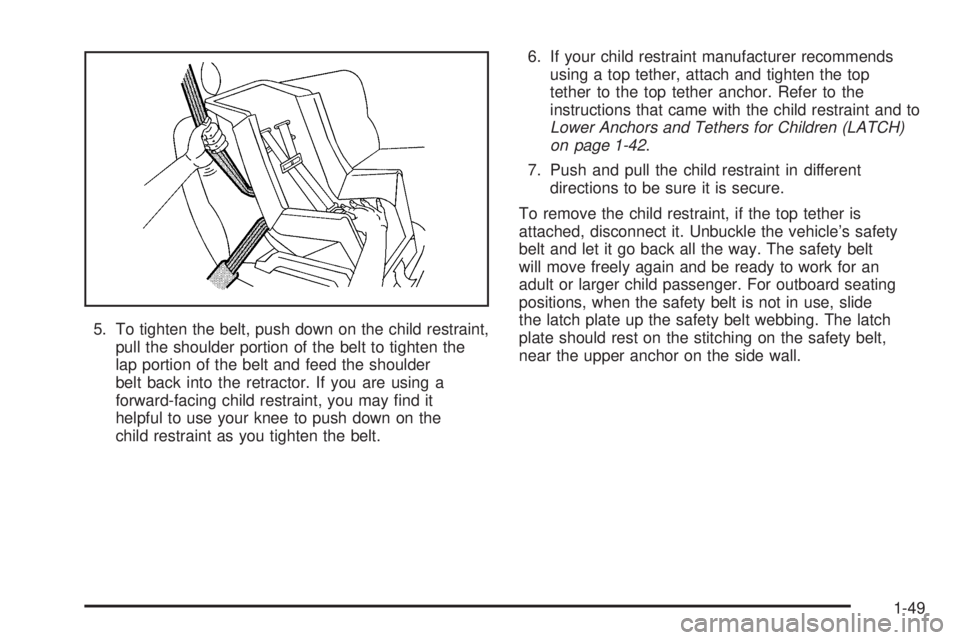
5. To tighten the belt, push down on the child restraint,
pull the shoulder portion of the belt to tighten the
lap portion of the belt and feed the shoulder
belt back into the retractor. If you are using a
forward-facing child restraint, you may �nd it
helpful to use your knee to push down on the
child restraint as you tighten the belt.6. If your child restraint manufacturer recommends
using a top tether, attach and tighten the top
tether to the top tether anchor. Refer to the
instructions that came with the child restraint and to
Lower Anchors and Tethers for Children (LATCH)
on page 1-42.
7. Push and pull the child restraint in different
directions to be sure it is secure.
To remove the child restraint, if the top tether is
attached, disconnect it. Unbuckle the vehicle’s safety
belt and let it go back all the way. The safety belt
will move freely again and be ready to work for an
adult or larger child passenger. For outboard seating
positions, when the safety belt is not in use, slide
the latch plate up the safety belt webbing. The latch
plate should rest on the stitching on the safety belt,
near the upper anchor on the side wall.
1-49
Page 56 of 368
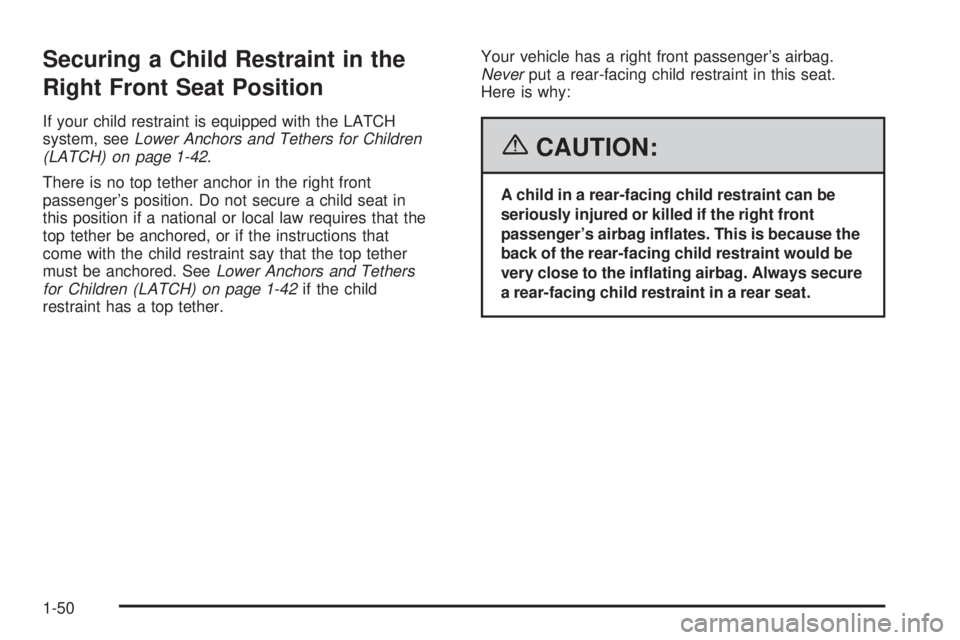
Securing a Child Restraint in the
Right Front Seat Position
If your child restraint is equipped with the LATCH
system, seeLower Anchors and Tethers for Children
(LATCH) on page 1-42.
There is no top tether anchor in the right front
passenger’s position. Do not secure a child seat in
this position if a national or local law requires that the
top tether be anchored, or if the instructions that
come with the child restraint say that the top tether
must be anchored. SeeLower Anchors and Tethers
for Children (LATCH) on page 1-42if the child
restraint has a top tether.Your vehicle has a right front passenger’s airbag.
Neverput a rear-facing child restraint in this seat.
Here is why:
{CAUTION:
A child in a rear-facing child restraint can be
seriously injured or killed if the right front
passenger’s airbag in�ates. This is because the
back of the rear-facing child restraint would be
very close to the in�ating airbag. Always secure
a rear-facing child restraint in a rear seat.
1-50